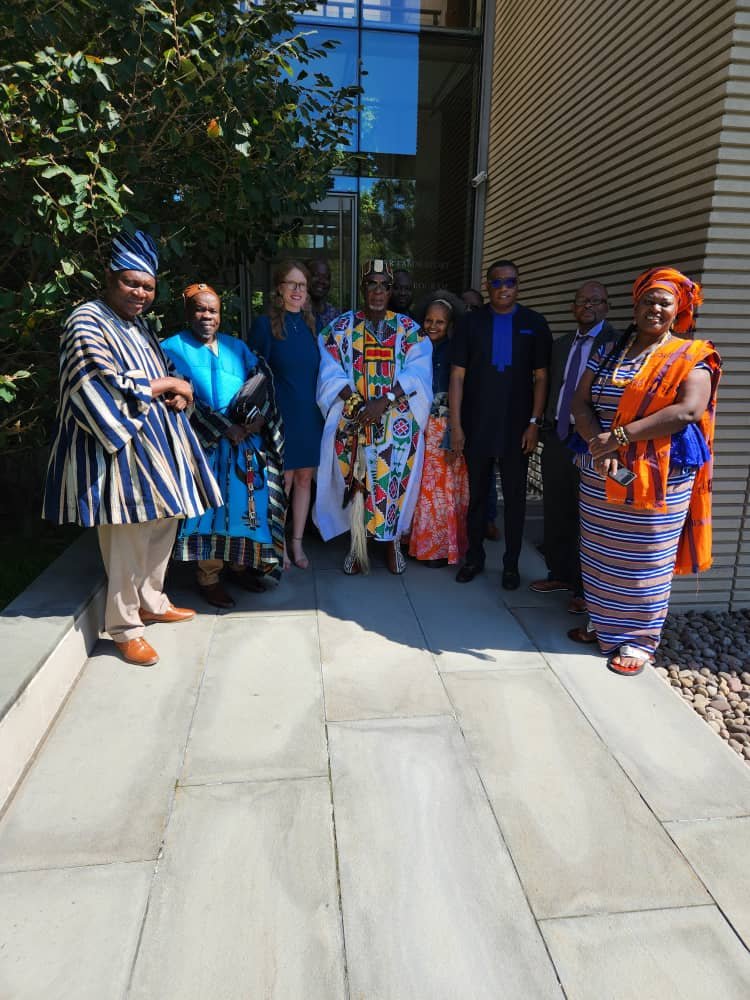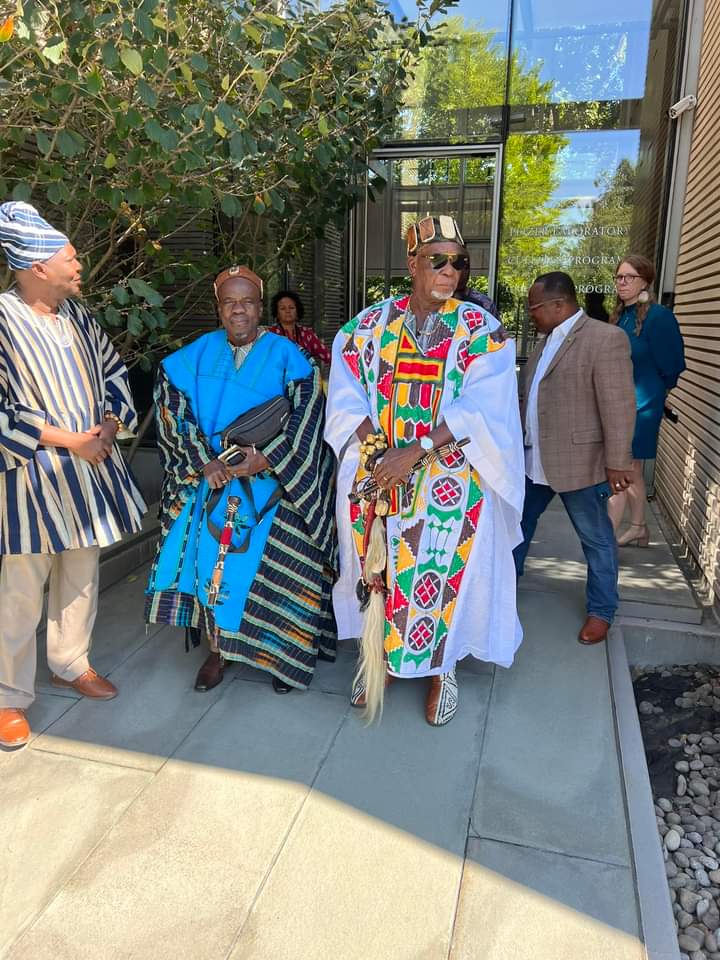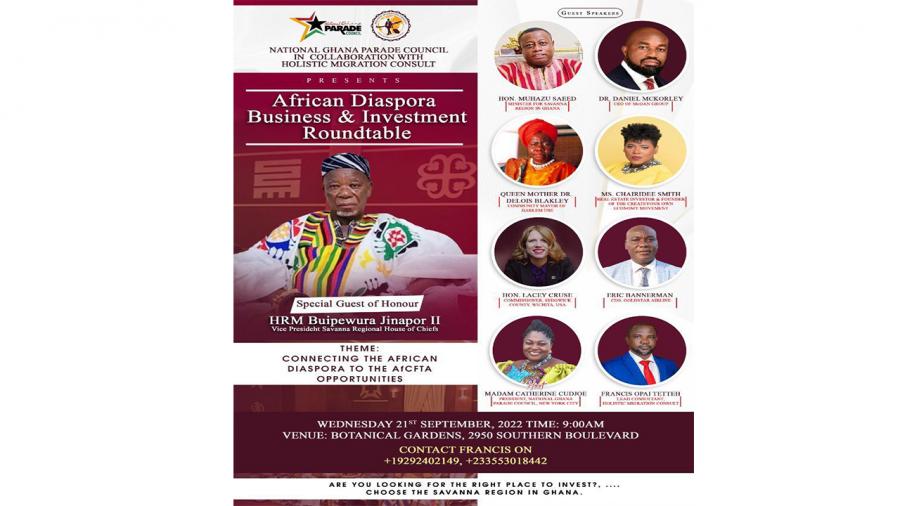
The paramount Chief for the Buipe traditional area and vice president for the Savannah regional house of chiefs, Buipewura Abdulai Jinapor II, the savannah regional Minister, Hon. Saeed Muhazu and others were in the United States of America for an Africa Diaspora Business and Investment round table held in New York to showcase to the african community in the US and the world on the investment potentials available in the region and the need for investors to take advantage of the investment opportunities and tourism exploitations in the region.

This was made in a presentation by HRH, Buipewura Jinapor II at this year’s Africa Diaspora Business and investment round table held at New York.

Read below the full content of his presentation
AFRICAN DIASPORA BUSINESS AND INVESTMENT ROUND TABLE, NEW YORK CITY
ADDRESS BY HIS ROYAL MAJESTY BUIPEWURA JINAPOR II
AT THE 5TH ANNUAL AFRICAN HERITAGE INTER AGENCY COLLABORATIVE EVENT FOR PEOPLE OF THE AFRICAN DESCENT TO CELEBRATE ITS EXPERIENCES AND CULTURE.
THE HISTORICAL CONNECTION BETWEEN GONJA AND THE AFRICAN DIASPORA
Paper Presented by
His Royal Majesty Jira Buipewura Jinapor II Paramount Chief of Buipe, Vice President of Savannah Regional House of Chiefs and Member of National House of Chiefs Ghana.
At NYC’s On African Diaspora Business and Investment Round Table,
Wednesday, September 21st, 2022
Botanical Gardens, Bronx NY.
Historical Connection Between Gonja and the African Diaspora
The President Catherine Cudjoe, Sponsors and co-sponsors of this round table, revered personalities, ladies and gentlemen [all protocols observed],
I bring you good tidings from His Excellency the President of the Republic of Ghana, the good and hospitable people of Ghana and Africa as a whole. The king of Gonjaland, and President of Savannah Region House of Chiefs Prof. Tuntunba Bore Essa I, sends you his heartwarming felicitations and prayers for a successful round table.
Madam President, it is delightful that I am here today to address the
African Diaspora Business and Investment Round Table, New York City
on the topic Historical Connection Between Gonja and the African Diaspora.
Madam President, history has it that the Gonjas appeared in modern Ghana very early in the 16th Century. Currently, their language is spoken by an estimated 600,000 people, almost all of whom are of the Gonja ethnic group of Savannah Region of Ghana.
The Gonjas belong to the larger Guan ethnic group and have the oldest written historical records. Also called Gonjas or ‘Ngbanye’ (the latter means ‘Brave Men’), the Gonjas derived their name from a corrupted Hausa phrase, ‘Kada Goro-Jaa’ (meaning land of Red Cola).
The Gonjas had their history recorded by Arab Muslims and Islamic scholars who accompanied them to this part of the world. According to Arabic manuscript and oral tradition, the Gonjas, who were originally Mandingo (also known as Mandinka), migrated from the country of Mande, that is, from the Mali Empire, many years before the Hejra Year 1000. They travelled through Segu in Southern Mali, and then approached the Bole area through La Cote d’Ivoire.
The earliest recorded version of the Jakpa epic, in substantially its modern form, is to be found in an ancient Arabic chronicle. From 1567 to 1712, there was a power struggle between two groups of Mandinka, the Manwura and his clan, and the Lata Ngbanya whose leader was Lata (Lanta) Jakpa.
At some time between 1550 and 1575, the great Askia Dawud of Songhay found that the supplies of gold from the southern country were getting smaller.
The main reason was that Akan gold producers had begun selling some of their production to Portuguese and other European traders along the Seaboard.
Askia Dawud accordingly dispatched a force of Mandinka armed cavalry to see what could be done. Dawud’s armed horsemen, the bulldozing tanks of these times, rode south from the neighbourhood of Jenne until they reached the Black Volta bend of modern Ghana.
These horsemen were the ancestors of the present day Gonjas. The horse riders were armed with swords and iron spears. In war the horsemen acted as cavalry. The Gonjas discovered that cavalry could not operate in the dense forest where the Akan lived and smelted gold.
Madam President, there is a historical connection between the Gonja and African-Americans. This link is through the infamous slave trade. The Gonja area of northern Ghana suffered severe and repeated raids from slave traders. The raids by Samori Toure and Babatu for slave capture caused untold hardships to the people of the middle belt zone of Ghana, where the Gonja are the largest group. We are meeting here today with some of the descendants of those slaves captured, sold and transported to Europe and the America.
Therefore, you are our brethren rather than you thinking that Elimina is your home. Elimina was only an exit point in Ghana.
Your home is the Savannah Region of the Republic of Ghana.
The siting of the slave market at Salaga in the East Gonja area further accentuated the prominence and misery that this dastardly human action brought on the Gonjas.
Gonja reacted courageously to this, by engaging the Ashanti in a war in 1875. Historians have recounted the bravery of the Gonja Chief called Kankranfo who was force to pay tribute of 300 slaves annually to the Asantehene.
To bring the barbaric and dehumanizing act to an end, Kankranfo of Daboya in a suicide mission, got himself together with a mission from the Ashanti Kingdom, consumed in blazing gun powder. The Asantehene of that time had sent an emissary made up of warriors to Daboya to demand the annual payment of slaves by the Gonja to the Ashanti Kingdom. In open and brave protest, he asked his people to set gun powder around him and burnt them alive.
This is the contribution of the Gonja Kingdom towards the world’s fight to stop slavery.
The Savannah Region of Ghana, up to date is suffering under these effects of the slave trade.
So now, the Gonja Kingdom that we have been talking about since 2019 Has Become the Savannah Region of Ghana. The Region occupies a very large geographical space.
The Region is the largest in Ghana.
The population of the Savannah region is sparse because of the dehumanizing slave trade at that time. The Region is blessed with abundance of natural resources, large expanse of agricultural land, several rivers (Black & White Volta confluence in the Gonja Kingdom), and other water bodies, large mineral deposits, and friendly people.
Madam President, to conclude, the Savannah Region is the largest Region in Ghana in terms of land mass with a total area of 37,862km2. It constitutes 16.09 per cent of the total land area of Ghana (238,533km2) which has the capacity to sustain agricultural production.
Historically, the people of this area suffered from the burdens of slave trade. The largest slave market of Salaga and large wells for bathing attest to this cruel depopulation of this ecological enclave. According to the earliest population data in 1960, the area was virtually uninhabited with 6.3 persons per km2. Logically, markets thrive where there are locally available resources hence the establishment of the slave market in Gonjaland precisely Salaga.
The ecological diversity of the region creates a great tourism potential. It is host to Mole and Bui National Parks and kenikeni forest reserves. Additionally, the area is host to the largest slave market market/wells, the Larabanga Mosque and the Mystic Stone, Daboya Smock Community/industry and salt (brine) wells, Buipe Mishirito (Burial Place of Ndewura Jakpa), Kulmasa eco-tourist sites of crocodile’s ponds, Kparia and Wawato water falls among others.
Similarly, approximately 18,482km2 of the region’s total land area is classified as agricultural land (World Bank, 2020). About 75,067 hectares of this land is under cultivation. Smallholder rain-fed farming using traditional technologies dominates the agricultural sector accounting for 80% of total agricultural production. Physical and biological characteristics of the agro-ecosystem, as well as socioeconomic factors, dictate what crops and farming systems will produce the greatest benefits or lowest risk for the farmer and household
Recent geological data has provided striking evidence of large quantities of crude oil and limestone deposits for commercial production.
My dear people of Savannah extraction in the Diaspora, I am making a passionate call on you to turn attention to the development of the Savannah Region. This is so because, there is no nation in the World that grew steadily without the contribution and support of the African Americans. Savannah Region needs your involvement in the development agenda of the Region.
We still remember painfully the millions of enslaved people (our brethren) who died being transported to Latin America and the Caribbean to work without pay. I plead for a minute silence and prayer for them
Thank you.
May our relationship last forever,
May God bless you and bless all of us.

















